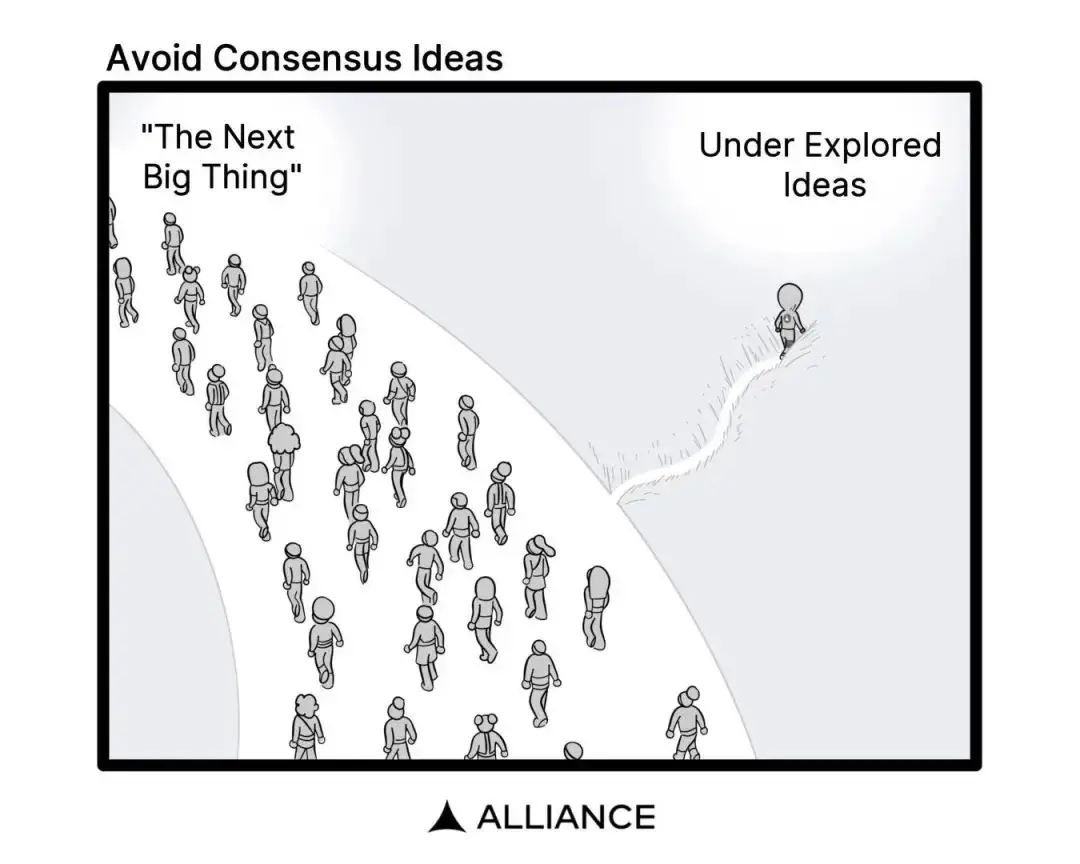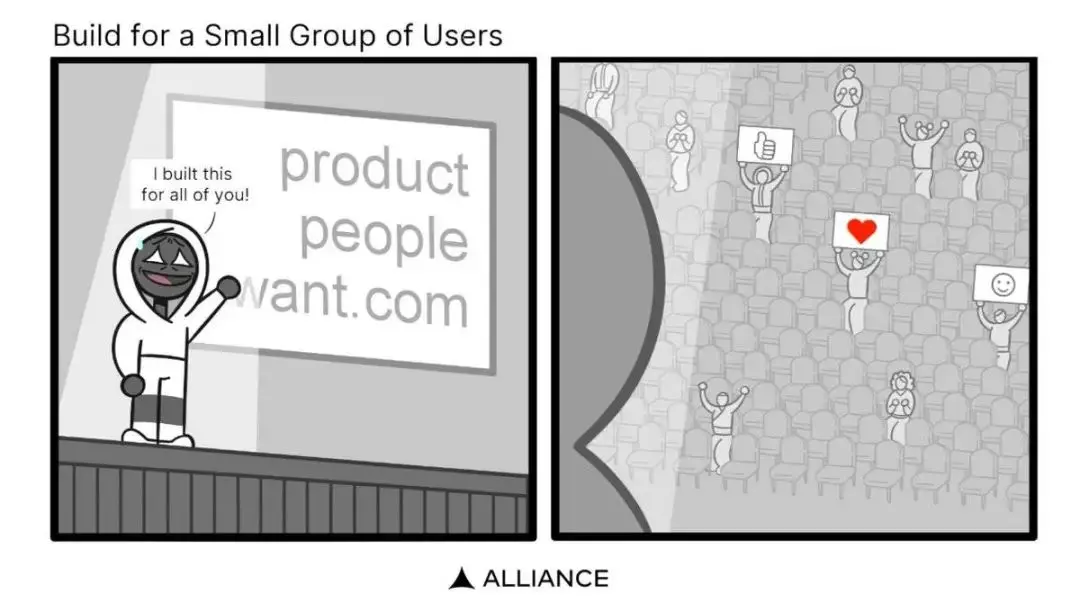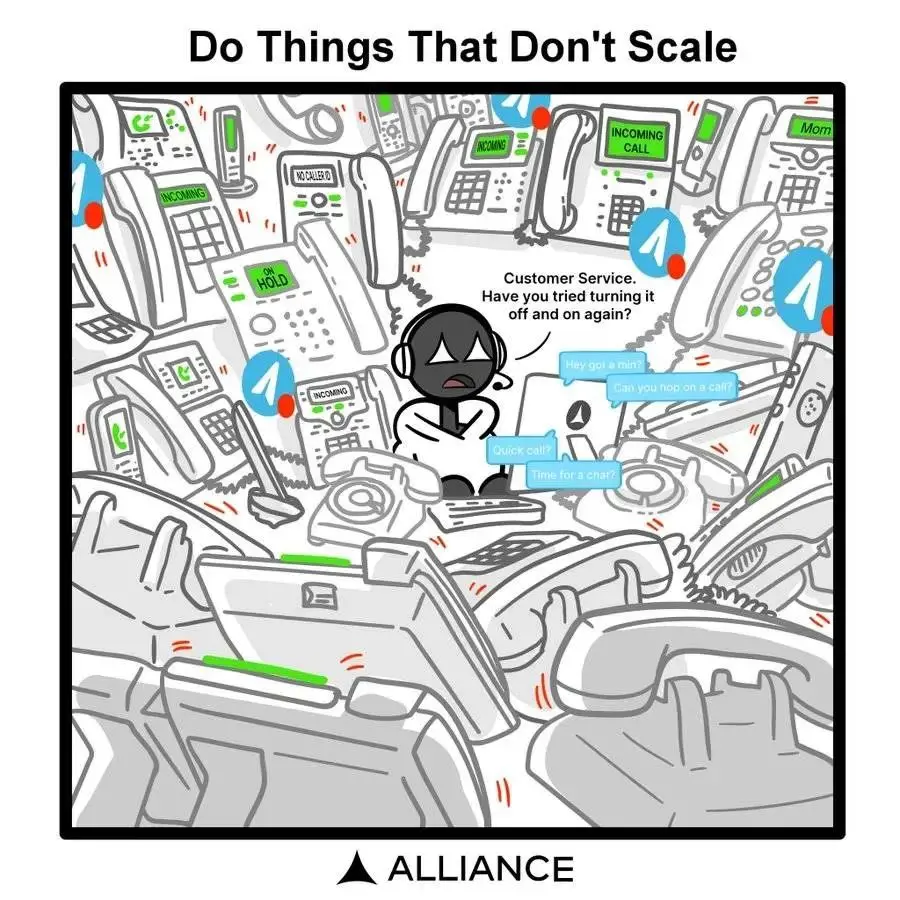Author: Imran Khan, Co-founder of AllianceDao
Translation: Foresight News
Start with Small Problems
Don’t aim for a massive market right away; instead, focus on solving a small, specific problem. This approach often contradicts the advice of VCs, who tend to push for solutions to big market problems. Instead, you should concentrate on issues affecting smaller user groups—by using crypto products daily, you can personally experience these problems. As thousands of new products are launched, use as many of them as possible to understand the pain points faced by everyday users. This way, you will identify actionable problems that truly need solving.
Starting small allows you to gain deep insights into user needs and optimize your product without the noise and complexity of a large market.
Avoid Consensus
Avoid chasing ideas that everyone believes are the next big trend. When an idea is widely accepted, the market is often saturated. Competing with established players requires a product that is ten times better than existing ones to stand out. Instead, focus on areas that have not been fully explored, where competition is less. This gives you more room and time to experiment and develop a unique value proposition.

Build Products for a Small Group of Users
Identify a core group of early adopters—about 25 to 50 passionate users who genuinely care about the problem you are solving. By focusing on their specific needs, you can build a solid foundation and cultivate real supporters. These early users will provide valuable feedback, helping you iterate and improve your product quickly. Over time, this process will naturally expand your user base. If people like what you build, they will naturally recommend it to friends and family.

Validate Your Hypotheses with a Minimum Viable Product (MVP)
Before investing significant resources (like money and time), validate your core hypotheses with a minimum viable product. This simplified version of the product should focus on addressing the main pain points you’ve identified. You need to release a product with minimal features but enough insights to help you decide whether to double down or pivot to other ideas. It also allows you to collect user feedback more quickly and may lead to completely unexpected learnings. Additionally, quickly releasing a product can give you an edge over competitors—many may be considering the same idea, and typically, the first to launch attracts attention.
Launch Your Idea Within 30 Days
Timing is crucial. Aim to develop and launch your minimum viable product within 30 days to leverage the momentum of your idea and start collecting user data as soon as possible. This rapid deployment process forces you to prioritize core features and avoid the pitfalls of over-planning.
Do Things That Can’t Be Scaled
In the early stages, personalized engagement is more important than building a complete product. Interact directly with users, handle customer support personally, and manually execute transactions that will be automated in the future. These unscalable efforts help you build strong relationships with early users and gain deep insights into their needs and behaviors. This approach not only allows you to build and launch quickly but, more importantly, it ensures that the product reaches users early.

Avoid Overbuilding; Use Existing Tools to Simulate
Avoid creating everything from scratch. For crypto entrepreneurs, it’s best to avoid building core infrastructure and instead collaborate with or leverage existing products to simulate the final solution. For example, use ready-made automated market makers (AMMs) like Uniswap or Raydium instead of developing your own AMM for a specific product. This can save resources and allow you to focus on refining your core product.
Recruit Users One by One Until You Reach 50
When building your initial user base, personalized outreach is crucial. Contact potential users one by one through email, social media platforms (like Twitter DMs), or community forums. This method allows you to interact with users willing to use the product and gain precise, candid feedback about it.
Continuously Seek Feedback and Iterate on Your Product
Maintain an ongoing dialogue with users. Regular feedback can reveal insights you may not have considered. Use this feedback to iterate and improve the product, ensuring it continues to meet users' evolving needs. Establishing this feedback loop is vital, as it keeps you closely attuned to user needs and helps you build a product that people truly love. Alon from Pump.fun reached out to 3,000 Twitter users to gain attention for Pump.
Don’t Take Feedback Literally
While user feedback is important, interpret it cautiously. Users may not accurately express their needs or may suggest ideas that don’t align with your product vision. You need to exercise judgment, discern potential issues, and address them in a way that aligns with your product direction.
Achieve Stability with 50 to 100 Daily Active Users
The goal is to achieve stable growth in daily active users (DAU), with an initial target of 50 to 100 daily active users. This level of engagement indicates that your product is gaining traction and becoming part of users' daily activities. Monitor user retention and engagement metrics to ensure you are building sustainable growth.
Refine Your Business Model
Once you have a stable user base, focus on achieving profitability. Develop a clear business model that outlines how your startup will generate revenue. Whether through transaction fees, premium features, or token sales, a clear business model is crucial for attracting investors and ensuring long-term viability.
Dig Deep into Data to Find Growth Opportunities
Data is your ally. Analyze your data thoroughly to understand what drives user acquisition, engagement, and retention. Identify key performance indicators (KPIs) that align with your business goals. Use this data to make informed decisions about marketing strategies, product features, and resource allocation.
Be Persistent: Reach Out via Email, Group Chats, and Social Platforms
Persistence pays off. Don’t hesitate to reach out multiple times to potential users, partners, or investors. Expand your reach through various channels like email, direct messages, group chats, and social media. Entrepreneurship often requires relentless networking and promotion. Always maintain an Always Be Closing (ABC) mindset.
Celebrate Small Wins and Take Breaks When Needed
Every milestone, no matter how small, is worth celebrating. Whether it’s launching a new feature or reaching a user benchmark, acknowledging progress can keep team morale high. Additionally, taking short breaks can prevent burnout and help you and your team maintain long-term efficiency.
Work Hard
Nothing can replace the importance of hard work. Building a successful startup requires dedication, long hours, and a willingness to put in extraordinary effort. Your commitment sets the tone for the team and can determine the difference between success and failure. Think of it this way: if your competitors are working 7 to 8 hours a day on their ideas, how many hours are you willing to work to win? Of course, I’m not suggesting you rely solely on overtime to succeed, but use this mindset to motivate yourself to work smarter and achieve victory.
Protect Your Equity
Be cautious about how much equity you give away, especially in the early stages. It may be tempting to offer a large equity stake to secure funding or talent, but maintaining control is crucial for shaping the company’s future. Consider alternative incentives and negotiate terms that align with your long-term vision. Ultimately, founders should retain enough interest to be rewarded for the significant time invested in the early stages.
Small Funding Will Teach You How to Be Frugal
Securing moderate funding will force you to prioritize core issues and learn to conserve resources. In the earliest stages, you should typically raise only $500,000 to $1 million. Operating on a lean budget will encourage founders to find creative solutions. This discipline can lead you toward a more sustainable business model and make you more attractive to future investors. Amazon founder Jeff Bezos once used a door as his desk to remind himself to save time and money.
Frugality
Adopt a frugal mindset in all aspects of entrepreneurship. Review every expense, avoid unnecessary operational costs, and focus funds on areas that directly promote growth. Frugality will extend your runway and provide flexibility when facing unexpected challenges or market changes.
Keep the Team Lean and Hire Sparingly
Be cautious when expanding your team. Each new hire should fill a key role that directly impacts the company’s success. A lean team is more agile, easier to manage, and less susceptible to the complexities of large startups. Staying lean allows you to pivot quickly and maintain a strong company culture. If you hire too many people, the company culture can deteriorate rapidly.
Click to learn about job openings at ChainCatcher
Recommended Reading:
Backroom: Tokenization of Information, a Solution to Data Overload in the AI Era?| CryptoSeed
免责声明:本文章仅代表作者个人观点,不代表本平台的立场和观点。本文章仅供信息分享,不构成对任何人的任何投资建议。用户与作者之间的任何争议,与本平台无关。如网页中刊载的文章或图片涉及侵权,请提供相关的权利证明和身份证明发送邮件到support@aicoin.com,本平台相关工作人员将会进行核查。




